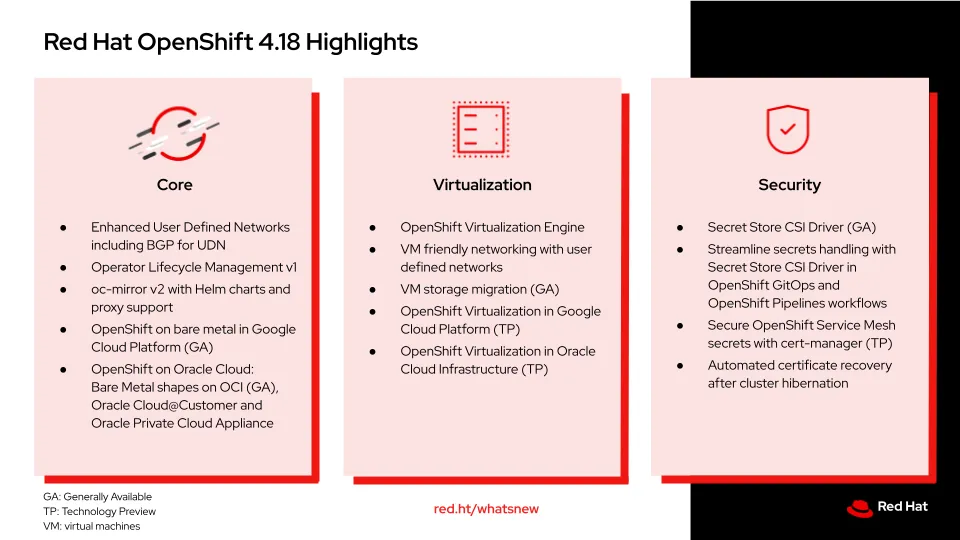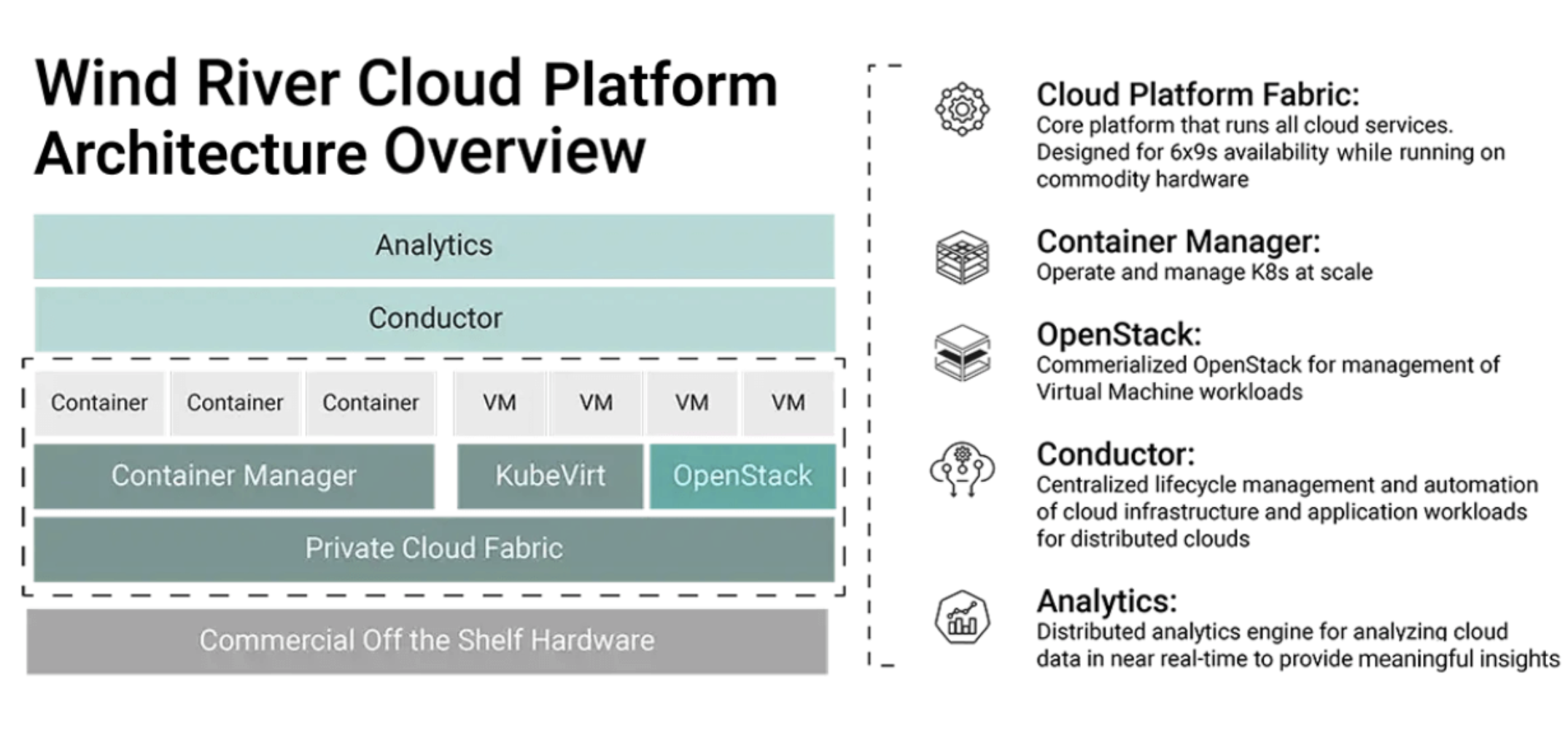Red Hat recently released OpenShift 4.18, bringing enhancements to the solution for networking, virtualization, security, and deployment flexibility.
Technical Details
Built on Kubernetes 1.31 and CRI-O 1.31, the new release improves cluster scalability, multi-cloud deployment, and automation while strengthening security and compliance capabilities.
Networking and Virtualization
- User Defined Networks (UDN): OpenShift 4.18 promotes UDN to general availability. UDN provides Layer 2/3 segmentation capabilities, supporting primary and secondary networks for container pods and virtual machines. It enables static IP assignments for VMs and supports live migration between nodes.
- Border Gateway Protocol (BGP): OpenShift 4.18 integrates BGP into OVN-Kubernetes, enabling dynamic route propagation between OpenShift clusters and provider networks. This allows third-party load balancers to access OpenShift pods directly. Future updates will extend BGP support with Ethernet VPN (EVPN), facilitating network extension across clusters and provider environments.
Deployment Flexibility
- vSphere Multi-vCenter Deployment: OpenShift now supports deployment across multiple vCenter clusters without shared storage. This expands high-availability deployment options in VMware environments, though multi-vCenter configuration is only available at installation.
- Expanded Bare Metal Support: OpenShift extends support for bare-metal workloads across major cloud providers. New support includes:
- Google Cloud: Bare-metal deployments now support C3, C4, C4A, and N4 machines.
- Oracle Cloud Infrastructure (OCI): OpenShift supports both connected and restricted network deployments via Assisted Installer and Agent-based Installer. Integration with OCI Cloud Controller Manager (CCM) and OCI CSI streamlines storage management.
- On-premises: OpenShift is now available for Oracle Compute Cloud@Customer and Oracle Private Cloud Appliance.
- OpenShift Virtualization Engine: This new offering provides a dedicated OpenShift environment for VM management, targeting organizations migrating from traditional virtualization platforms.
Security and Secrets Management
- Operator Lifecycle Management (OLM) v1: OpenShift refines operator management with a single ClusterExtensions API, enhanced GitOps integration, and persistent reconciliation for automatic failure resolution. Security improvements include user-defined ServiceAccounts to limit OLM’s permissions.
- Secret Store CSI Driver Operator: Now generally available, this feature enables workloads to securely retrieve credentials from external secret managers without persisting secrets in Kubernetes. This supports compliance in regulated industries.
Automation and Service Mesh Enhancements
- oc-mirror v2: Enhancements to OpenShift’s mirroring tool include improved performance, caching, proxy support, and Helm chart mirroring. These updates reduce bandwidth consumption and improve efficiency in disconnected environments.
- OpenShift Service Mesh 3.0: OpenShift transitions from Maistra to Red Hat’s Istio distribution, adding support for Istio 1.24 and Kiali 2.4. Key enhancements include:
- Multicluster topologies.
- Canary updates for the Istio control plane.
- Integration with OpenShift GitOps, Observability, and OpenShift Virtualization.
- cert-manager v1.15 with istio-csr: The cert-manager Operator integrates with OpenShift Service Mesh, enabling automated certificate retrieval and signing for Istio workloads.
Cluster Management and Recovery
- Automated Cluster Hibernation and Recovery: OpenShift clusters can now be suspended for up to 90 days and restarted with automatic recovery of expired certificates. Single-node OpenShift clusters can be shut down for up to one year without requiring backups.
- Effortless VM Storage Migration: OpenShift Virtualization now allows migration of Persistent Volume Claims (PVCs) between storage classes while VMs are running, streamlining storage management.
Analysis
Red Hat OpenShift 4.18 brings new features that improve network flexibility, security, and hybrid cloud deployment. The expansion of bare-metal support across Google Cloud and Oracle Cloud Infrastructure strengthens OpenShift’s position as a multi-cloud Kubernetes platform. Enhanced operator lifecycle management and automated cluster recovery increase OpenShift’s enterprise appeal, particularly for customers seeking to streamline operations in hybrid environments.
From a competitive standpoint, OpenShift 4.18 advances Red Hat’s ability to compete with VMware Tanzu and Google Anthos in multi-cloud Kubernetes management. OpenShift Virtualization Engine provides an alternative to traditional virtualization platforms like VMware vSphere, following a broader industry shift toward Kubernetes-based virtualization. Additionally, improvements in registry mirroring and secret management enhance OpenShift’s security posture, making it more attractive to regulated industries.
Overall, OpenShift 4.18 reinforces Red Hat’s commitment to hybrid and multi-cloud Kubernetes deployments, enhancing its appeal for enterprises modernizing their infrastructure. The release places OpenShift competitively against VMware and cloud-native Kubernetes services while also maintaining a strong focus on security, automation, and operational efficiency.
Competitive Outlook & Advice to IT Buyers
The Couchbase Edge Server competes directly against solutions like MongoDB Realm, AWS IoT Greengrass, and Azure SQL Edge.
These sections are only available to NAND Research clients. Please reach out to [email protected] to learn more.





